**Enjoy the first month of your Whoop membership for free ($30 value) when you use this link to purchase
WHOOP Strap 3.0 Review
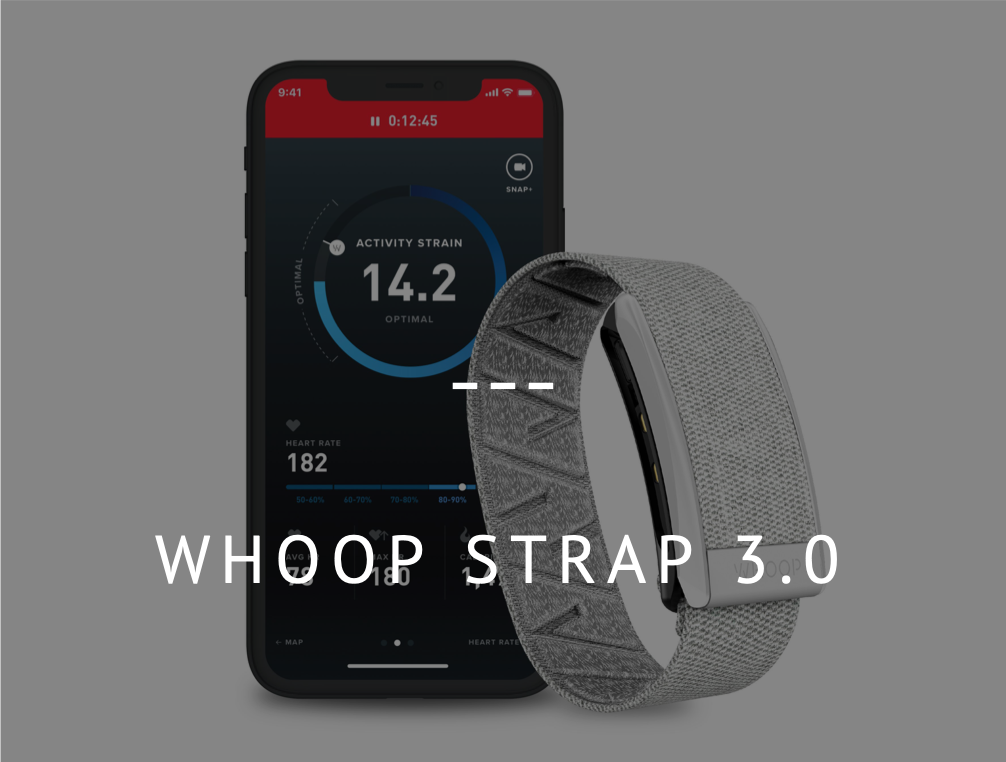
The WHOOP Strap 3.0 Review
The Whoop Strap 3.0 has been live for a few months now, taking the revolutionary performance tracker to new heights. If you’re familiar with Whoop 2.0 (see our review here), you’ll appreciate the numerous changes that have been made to this version.
With upgrades that improve the user interface, extend the battery life, and revamp the strap itself, the Whoop 3.0 has extended what many feel is a large lead in the wearable performance tracker market. After having now spent a few months as a team testing the Whoop Strap 3.0, here are my thoughts on how it compares to the original.
Battery Life
One of the most exciting upgrades with the Whoop 3.0 is the battery. The traditional battery life for the strap runs for about 44 hours on a full charge according to Whoop, which means you have to charge just about every other day.
With the Whoop 2.0, I can’t tell you how many times I woke up with incomplete recovery and sleep data because I forgot to check my battery percentage that night, resulting in skewed recovery data on a weekly basis.
The team at Whoop made a serious upgrade to their 3.0 strap, upping it to 5 days of battery life, a 300% increase.
In over 2 months of using the Whoop 3.0, I have yet to allow this bad boy to die, not because I’m suddenly that much more diligent, but because I only have to remember to charge it about once or twice per week. The strap is no longer an additional thing on my daily to-do list, but something that blends into the background of my day, as it should.
Battery Life: 5/5
ProKnit Band
Comfort is everything when it comes to a wearable performance tracker since you quite literally don’t ever take it off.
The ProKnit Band features high tenacity filaments that absorb sweat, giving you the best of both worlds between stretch and durability, while also including an internal rubber strip to prevent strap slippage when sweating.
One of the biggest issues with the traditional Whoop 2.0 strap was the part of the band that overlapped would constantly come out from underneath the outer strap and have to be adjusted at least once every day or two. For those of you with OCD, imagine a set of shoelaces that would never stay tied. Think about that for a second and I guarantee you’ll start to itch.
In my first year, I purchased 3 different straps that Whoop offered, but each had its own issue (from drying time to comfort, there was always a downside).

Whoop Strap 3.0 with ProKnit vs Whoop 2.0 with Nanostretch Band
The ProKnit Band is stable enough to stay put during high velocity movements like medicine ball throws, etc. without it flying off your wrist, and comfortable enough to sleep in and perform in during everyday training sessions.
Given that the Whoop strap is made to wear 24/7, let’s also touch on another factor: smell. The older Whoop Strap options all seemed to absorb sweat and moisture, and would definitely hold on to odors if not washed at least a couple times a month (soap and water in the shower worked fine). For what it’s worth, I haven’t had any issues thus far with the the ProKnit band – it seems to be significantly more resistant to odor, just a couple months in.
ProKnit Band: 5/5
Strain Coach
Another new and awesome feature with the Whoop 3.0 update is the inclusion of the Strain Coach. Prior to workouts, Strain Coach recommends an exertion level based on your recovery score and the strain value you have already compiled throughout the day.
This is a valuable tool for athletes in order to monitor workout intensity on a daily basis, giving you the insight to either tone down RPE (rate of perceived exertion) or kick it up a notch. This concept gives athletes the ability to optimize training sessions in conjunction with their recovery score on any given day.
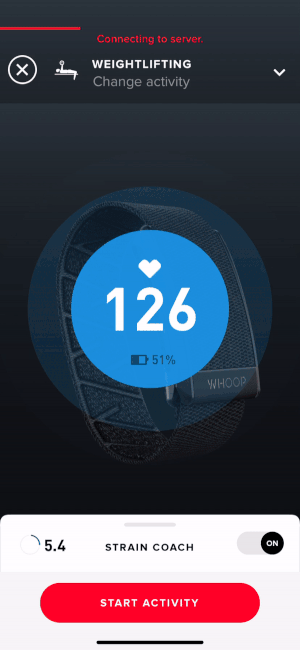
Strain Coach may have its applications in workload management during training by directly monitoring the given strain during a session to match RPE for that given day.
Something we are going to be exploring with our coaching staff is the relationship between cardiovascular strain during an activity (monitored by Whoop) and tissue/joint stress (monitored by platforms and tools like the Motus Sleeve), to explore how those data sets relate to performance on an everyday basis.
In short, the Strain Coach helps “auto-regulate” your training – matching your intensity to your readiness – on any given day. This pairs well with auto-regulation based training systems which go into further detail on how to adjust your sets, reps and training intensity up or down depending on the day.
“Prior to workouts, Strain Coach recommends an exertion level based on your recovery score”
Team Platform
Athletes are some of the most competitive people on the planet. Here at Tread Athletics, members of our staff still continue to train at high levels, giving us the ability to relate to our athletes’ own training programs. With the introduction of the Whoop Team Platform, we now have yet another variable and platform upon which to compete.
The Team Platform gives insights into each member’s scores in regards to their strain, recovery, and sleep performance. At any given point in time, you can check in and compare stats amongst each other.
Naturally, our staff began a recovery competition amongst the coaches to see who could have the most daily wins in a given month.
I’ll be honest, this was a very powerful compliance booster, and I found myself getting to bed earlier than normal, knowing that everybody would see my abysmal score if I stayed up a bit too late.
This adds in group accountability – something I’ve consistently recommended to coaches when it comes to weight, nutrition and strength tracking with their athletes. Bringing that information into the public sphere turns on the competitive side of the brain. I love that Whoop decided to tap in to this psychology.
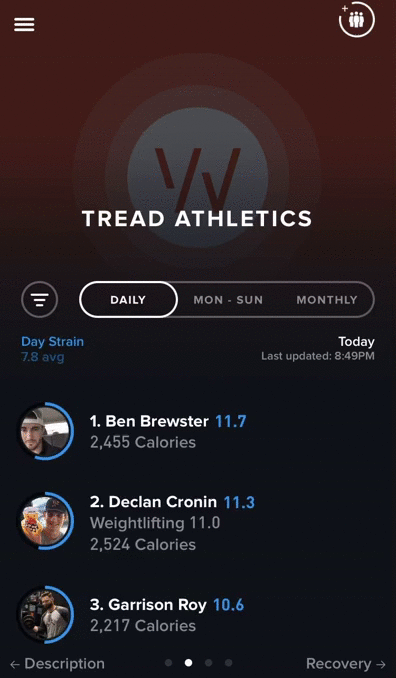
“Using the Team Platform, we began a monthly recovery competition”
My only complaint is that the process of setting up a Team within the Whoop platform requires a back and forth with customer service to set up the squad, and individual codes are sent to each athlete to join the newly created group. Don’t get me wrong, I have had awesome experiences with Whoop Customer Service (from replacing my battery pack to troubleshooting app functionality) but it would be ideal if you didn’t have to reach out to Whoop directly to add members to a Team.
In the future we plan to add athlete groups so they can compete for top recovery status as well.
Team Platform: 4/5
Whoop Live
What if you could broadcast your training sessions live and overlay your metrics on video? Enter Whoop Live.
Whoop Live not only gives users the ability to create virtual snapshots of their data values and save them to the camera roll, but gives users the ability to record live workouts with real time data similar to an Instagram Live Stream and share it on social media.
This is more of a ‘cool factor’ than something I’ve used on a consistent basis, but it’s a nice feature to have nonetheless.
Whoop Live: 4/5
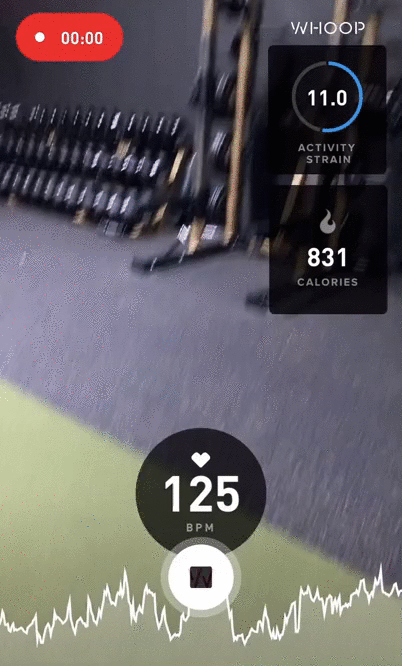
Whoop Live turns your workouts into a live feed for your followers
Data Analytics
Data analytics is the bread and butter of the Whoop platform, providing users with some of the most interactive and extensive data and metrics on the market today.
A couple things we noticed in comparison with the older Whoop 2.0 Strap:
First, we noticed that the estimated calories burned throughout the day was reduced (almost 500 calories per day in my case, from averaging mid 3,500’s to low 3,000s). Because I do track my bodyweight and caloric intakes, I tend to have a pretty good idea of how accurate these estimates are for my situation, and it seems likely that Whoop had been getting consistent feedback from users that it was overestimating caloric intakes, something I had been concerned about for a while myself.
For my personal situation, the Whoop now seems to slightly underestimate calories burned (I lose weight / am hungry if I don’t eat above that number), but it’s definitely closer than the 2.0 was. That being said, it’s probably unrealistic to expect any fitness tracker to be more accurate than this – within a couple hundred calories is very impressive and still gives a good indicator of how to adjust my nutritional intake day to day if I have particularly active (or lazy) days.
Sleep tracking accuracy appears to have improved as well, with significantly less errors regarding time in bed and sleep duration. Without accurate sleep duration, recovery scores are pretty much useless and create an inaccurate data set. One of my bigger problems with the Whoop Strap 2.0 was occasionally waking up in the morning with incomplete sleep data regardless of battery percentage, and having to go back into the app and manually estimate my sleep and wake times.
This data consistency has been greatly improved, to the point where I can’t remember when I last had incomplete sleep data.
Happy camper.
Data Accuracy: 5/5
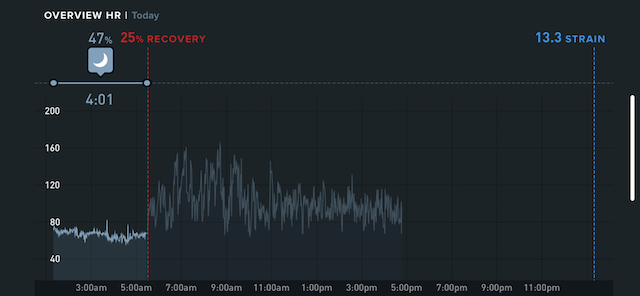
“The data consistency has improved to the point where I can’t remember when I last had incomplete sleep data.”
Pricing Structure
Let’s talk money.
The initial pricing structure for the Whoop 2.0 was $500.00, unless you landed one of their sales, which was a one time fee for the strap and the app.
While this was admittedly steep, it had the benefit of no ongoing costs associated with maintaining and using the strap.
However, Whoop’s new pricing structure now gives you the option to pay a monthly fee for a contracted amount of time, which both lowers the up front cost but gives you an ongoing maintenance fee which could come out to more money if you plan to use the strap for multiple years.
Here’s a look at the current structure as of the publishing of this review:
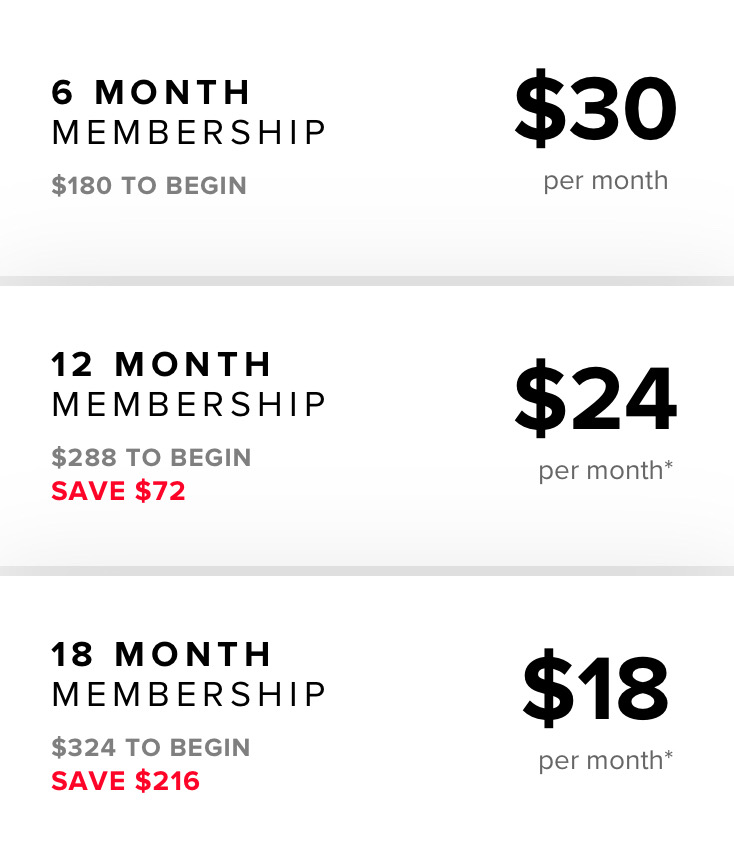
New Whoop Membership Options Ranging from 6-18 Months
Worth noting: users like me who purchased the Whoop 2.0 before the introduction of the new pricing structure, are upgraded to the 3.0 Strap for free with no monthly fee.
While overall I think this is a good business move by Whoop to lower the barrier to entry for their product, it does bump up the long term cost for serious users who aren’t grandfathered in to the original payment structure and plan to use it for several years.
I wish they still had the option to purchase a life-time pass for $500 and avoid the subscription service.
That being said, I still stand by my first take on the Whoop 2.0 that this is probably worth about what you’re paying for Netflix to gain access to such extensive recovery metrics if you’re looking to gain a competitive edge.
But is it worth getting as a Birthday present for your not-so-serious cousin who does a couple Zumba classes here and there? Probably not.
Pricing structure: 3/5
Final Thoughts
I was already a fan of the Whoop Strap 2.0, but with a wide range of needed upgrades including battery life, strap comfort and a team platform, they have won me over again. While many people will rejoice at the lower up front cost, I wish that Whoop had left a “lifetime” payment option to their pricing structure for serious users who plan to use the strap for multiple years.
After reading this Whoop Strap 3.0 review, for those of you who are interested, you can check out the Whoop Strap 3.0 at their website.
** Enjoy the first month of your membership for free ($30 value) if you use this link to purchase **
(You can check out our review of the Whoop Strap 2.0 if you’re curious about some of the original features of the strap, all of which are still included in the Whoop 3.0)

